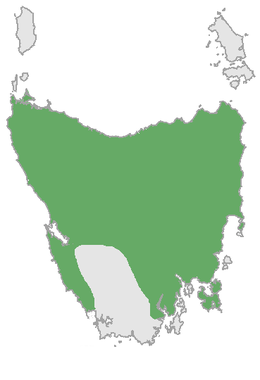Thylacinus cynocephalus
| Thylacine Temporal range: Pliocene - Holocene, 4–0.0001 Ma |
|
|---|---|
 |
|
| Thylacines in Washington D.C., c. 1906 | |
| Scientific classification | |
| Kingdom: | Animalia |
| Phylum: | Chordata |
| Class: | Mammalia |
| Infraclass: | Marsupialia |
| Order: | Dasyuromorphia |
| Family: | †Thylacinidae |
| Genus: | †Thylacinus |
| Species: | †T. cynocephalus |
| Binomial name | |
|
Thylacinus cynocephalus (Harris, 1808) |
|
 |
|
| Historic Thylacine range in Tasmania | |
| Synonyms | |
|
List
|
|
The thylacine (/ˈθaɪləsiːn/ THY-lə-seen, or /ˈθaɪləsaɪn/ THY-lə-syne, also /ˈθaɪləsɪn/;Thylacinus cynocephalus) was the largest known carnivorous marsupial of modern times. It is commonly known as the Tasmanian tiger (because of its striped lower back) or the Tasmanian wolf. Native to continental Australia, Tasmania and New Guinea, it is believed to have become extinct in the 20th century. It was the last extant member of its family, Thylacinidae; specimens of other members of the family have been found in the fossil record dating back to the late Oligocene.
...
Wikipedia

